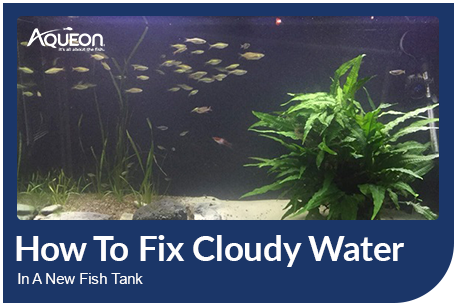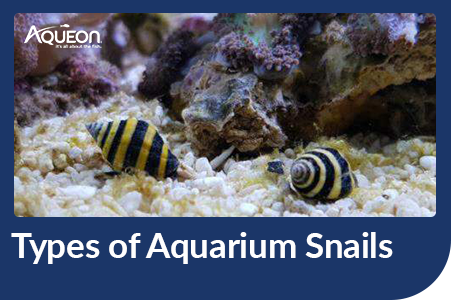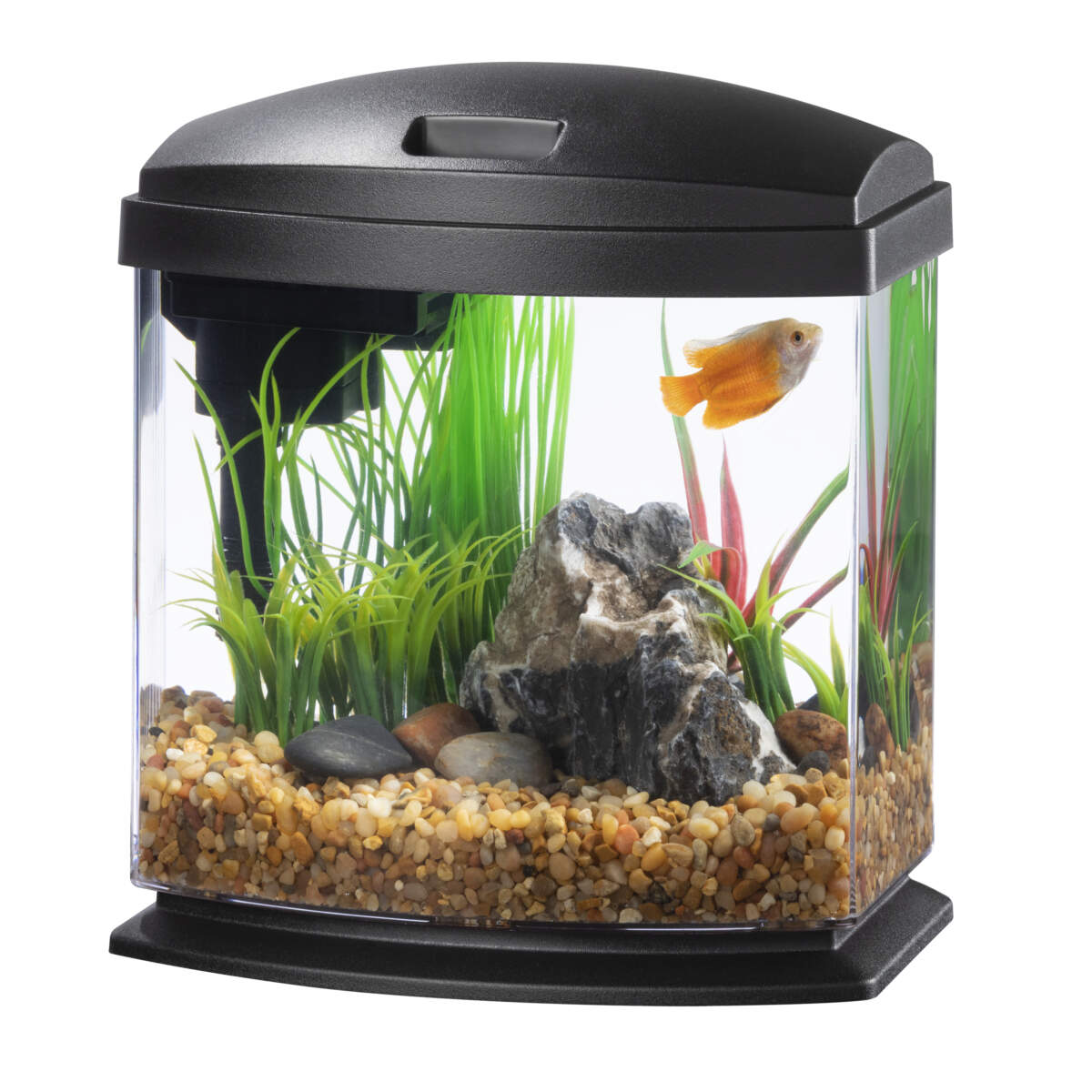Collecting and Keeping Native Fish
Keeping native North American fish in an aquarium is a lot of fun, and it is a great way to learn about them! Besides offering all the characteristics of exotic tropical fish, they also help us understand local aquatic habitats and how our activities affect the ecology of our environment. For seasoned aquarists, they can be a new and exciting group of fish to get to know and enjoy. If you sport fish, keeping natives in an aquarium allows you to re-create the habitats these fish occupy in nature and observe them in your home or workplace. In some ways, native fish are easier to keep than tropical fish. Aside from trout, most native fish do best between 50°and 70°Fahrenheit, and if you collect them locally, they are already adapted to your water chemistry. Many native species adapt readily to aquarium life, accept standard fish food and certain types, such as sunfish, develop distinct personalities!
You might think of fish that come out of our rivers and lakes as dull, grayish-brown creatures that belong more on a dinner plate than in an aquarium, but did you know that many species that swim right in our back yards are highly prized by aquarists in other parts of the world for their brilliant colors and interesting behavior? For example, male Pumpkin seeds, Longear Sunfish and Rainbow Darters in full spawning colors rival any fish from the Amazon or the African Rift Lakes. To aquarists living outside of North America, our native fish are their exotics! Of the over 1,000 species of freshwater fish native to North America, some are ideally suited to aquarium life. Of course, there are some that are not due to their large adult size, finicky eating habits, specialized requirements or a combination of these factors. As with any type of fish, it is important to research the species you are interested in keeping before getting started.
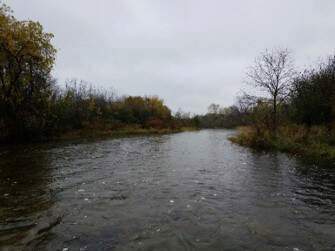
Collecting native fish locally is fun and rewarding! Check out prospective collection sites ahead of time for access, habitat type and safety concerns.
Some questions to ask in advance would be:
How big will they get?
What do they eat?
What other types of fish do they get along with?
What water conditions do they need?
Think things over carefully before getting started, as releasing fish you no longer want or are unable to care for back into the environment is not an option, whether they are native or exotic. After they have lived in captivity, releasing fish back into the wild is not only potentially detrimental to them and the environment, but in most parts of the country, it is illegal!
Finding Native Fish
One of the biggest challenges facing anyone who wants to keep native fish is where to get them. Local hatcheries can be a good source, but most facilities produce game fish. These are not always good choices for aquariums, but still worth checking out. One positive aspect of hatchery fish is that they adapt well to aquarium life because they are bred in captivity and are already eating dry food. They are also less likely to be carrying parasites or other diseases. A few specialty aquarium shops stock natives, typically as fingerlings right after the spawning season, but it is not common. Local aquarium societies often have members who keep and sometimes breed native fish, and these folks will often organize collecting trips you can join. The North American Native Fishes Association (NANFA) is another good source for captive bred natives as well as local collecting trips. The most fun and meaningful way to acquire native fish is to collect them yourself!
Collections
The best collection methods are dip nets, traps and seines, with seining being the most productive. Before you grab your nets, buckets and head out in search of fish, do some homework!
First, research what types of fish are common in your area. Make sure they are suitable for the size aquarium you are setting up as well as your fish keeping skills and available food supply. Next, be familiar with the regulations in your area: where you can collect, what species you can collect, what collection methods you can use and whether you need a permit or fishing license. Be aware of any endangered species that might be present and how to identify them. Good sources of information are the North American Native American Fishes Association (NANFA) and your local Department of Natural Resources or equivalent. Once you have an idea of where to go collecting, make one or two reconnaissance trips to proposed sites to check access, water depth and water parameters such as temperature, pH and hardness. Make note of bottom composition (you don’t want to sink up to your knees in muck) as well as the type of structure present – aquatic plants, rocks, logs, fallen trees, etc. – so you can replicate these conditions in your aquarium, leaving out the downed trees, of course! This may require donning a mask and snorkel, which has the added benefit of giving you some idea of what fish species are present. Most aquarium species can be collected in water that’s knee-deep or less, but safety is a concern if you will be collecting in fast-moving streams or deeper water, especially during cold weather. NEVER go collecting alone! Always be respectful of private property, obey all law enforcement officers and natural resource/conservation agents you encounter and avoid any actions that may have a negative impact on the environment.
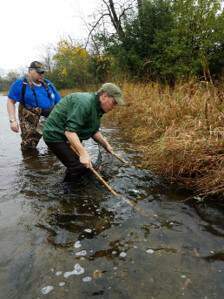
Seine overhanging stream banks, plant beds and riffle areas for best results!
You’ll need the following equipment for collecting:
- Buckets with lids
- Nets – seine, dip net
- Waders or water shoes
- Battery operated air pump or O-Tabs
- Clear container for viewing fish
- Permits (where required)
- Fish identification guide
- Notebook to record site details, weather, numbers and species collected
- First Aid kit
- Change of clothes
- Drinking water, lunch or snack
Weed beds, overhanging banks and rock fields are good places to collect. Decide how many fish you want to bring home and place fish of interest in buckets with aerators or O Tabs which are small containers that once opened, release tiny bubbles that will keep water oxygenated for several hours. Keep buckets out of direct sunlight and check fish regularly for signs of stress, especially in hot weather. As you collect, release small fish and rare or endangered species right away. You cannot keep everything you catch, so once you have a fair number of fish in the buckets, cull out the best-looking ones by placing them in a clear container for inspection. Take only what your aquarium can hold safely and release any unwanted fish immediately. After choosing your fish, bag them individually with plenty of air in each bag or place them in an aerated bucket for transport. Then pack up your gear, collect your trash and head home!
Acclimation
Acclimate your new fish as you would store-bought specimens, allowing ample time for temperature and pH adjustment. After you place them in the aquarium, leave the light off for a few hours to reduce stress and give the new fish time to adjust to their new home. Keep a secure lid on the tank to prevent jumpers.
One final note: Avoid mixing natives with tropical fish. If you already have a native tank, quarantine new acquisitions in a separate aquarium for 15 to 30 days to avoid introducing diseases.
There are hundreds of native fish species that are suitable for aquariums. Here are some of the more common groups:
Centrarchids (Family Centrarchidae)
Centrarchids are the sunfish or bream that many of us fished for as kids. They are distant relatives of cichlids and tend to exhibit the same hardiness and territorial behavior as their cousins. Some centrarchids, such as bass, get quite large and require live food, so they are not ideal aquarium fish. Although bluegills, green sunfish, pumpkinseeds, long-eared sunfish, rock bass and several other species adapt rather well to captivity.
It should be noted that centrarchids may be considered game fish in some areas and you may require a permit to keep them in captivity. These fish need plenty of room to thrive and are best kept in aquariums of 75 gallons or larger with good filtration. They can be aggressive towards tank mates, so make sure the tank is well-decorated to create territorial boundaries. It is best to start out with young specimens, as they tend to be more peaceful and quickly learn to eat flake and pellet foods.
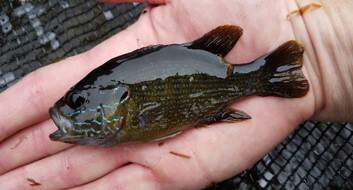
A Green Sunfish (Lepomis cyanellus)
Darters (Family Percidae)
Darters are small fish that lack an inflatable swim bladder and spend most of their time on the bottom or perching on rocks or logs. Many species like fast-moving water and are frequently found in rocky riffle areas, hopping or "darting" about, vying for the best spots. Most darters spawn in spring, and males become considerably more colorful. Male Rainbow Darters (Etheostoma caeruleum) become so brightly colored they could be mistaken for saltwater fish. Some darter species are becoming increasingly rare due to habitat destruction and other causes and are listed as threatened or endangered. When collecting, make sure you are aware of which species are legal to collect and which are not. Many of the over 150 species of darters found in North America grow to less than 4 inches and can be kept in aquariums of 30 gallons and larger. Choose a long, low tank as opposed to a tall narrow one. Place a circulation pump or filter discharge at one end to create a lateral current to simulate the fast-flowing water they live in. Decorate the tank with rocks and pebbles to provide cover.
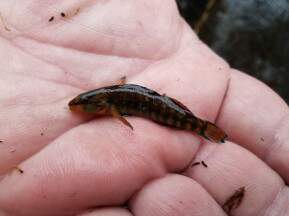
A male Rainbow Darter (Etheostoma caeruleum)
Minnows, Shiners & Chubs (Family Cyprinidae)
This group represents perhaps the most commonly encountered fish in streams, rivers and lakes of North America. Shiners, "minnows" and dace are peaceful schooling fish that do well in native community aquariums with just about anything that will not eat them. They are middle to upper level swimmers that live in many different habitats. During spawning, which typically occurs in spring, males of many species become brilliantly colored, making them among the most desirable native fish for aquariums. Shiners mix well with darters.
Chubs are typically larger than shiners and some species can be boisterous. They do best in aquariums of 75 gallons or larger and make good tank mates with similarly sized centrarchids. When decorating an aquarium for shiners, dace and chubs – or any native fish for that matter – try to match the habitat where they were collected.
Catfish (Ictaluridae)
Bullheads, channel catfish and certain other species of catfish are not suitable for home aquarists because they get to be quite large and prey on other fish. Madtoms, on the other hand, stay relatively small (less than 5 inches) and make good neighbors in a native community tank. They can be found in fast-moving streams as well as lakes and quiet backwater habitats. A few species are threatened or endangered, but the Tadpole Madtom (Notorus gyrinus) is a common catfish that makes a great aquarium fish!
Most madtoms are nocturnal, and therefore, will be somewhat secretive at first. Once they grow accustomed to their new home, however, they will start to come out for food and eventually at other times during the day. They enjoy sinking pellets and frozen foods such bloodworms but remember they will swallow anything they can fit in their mouths including small fish resting on the bottom at night! Provide your madtoms with hiding places such as caves, grottos, dense plants or hollow logs. Use caution when handling these fish in a net, as they have sharp spines that can inject a venom like a bee sting.
Keeping native North American fish in an aquarium is a rewarding activity for young and old. It can open new doors for aquarists of all experience levels and is a great family activity!
Please join our newsletter, connect with us on Facebook or contact us for more information.


